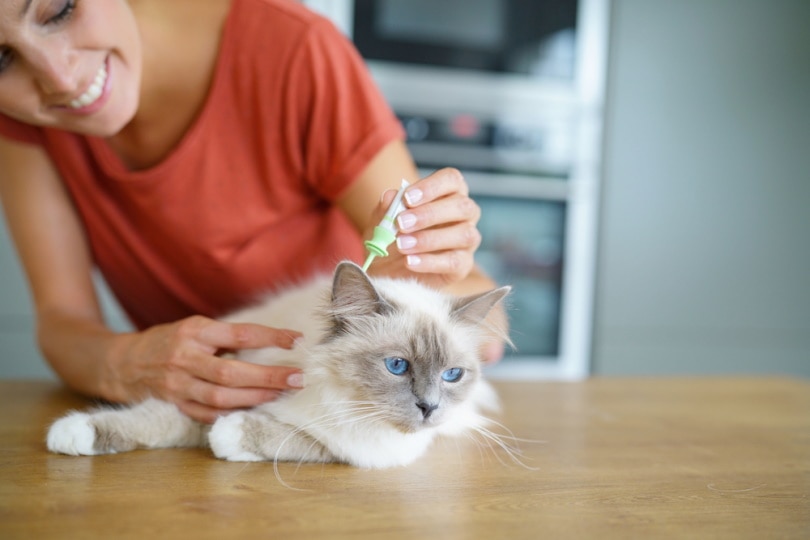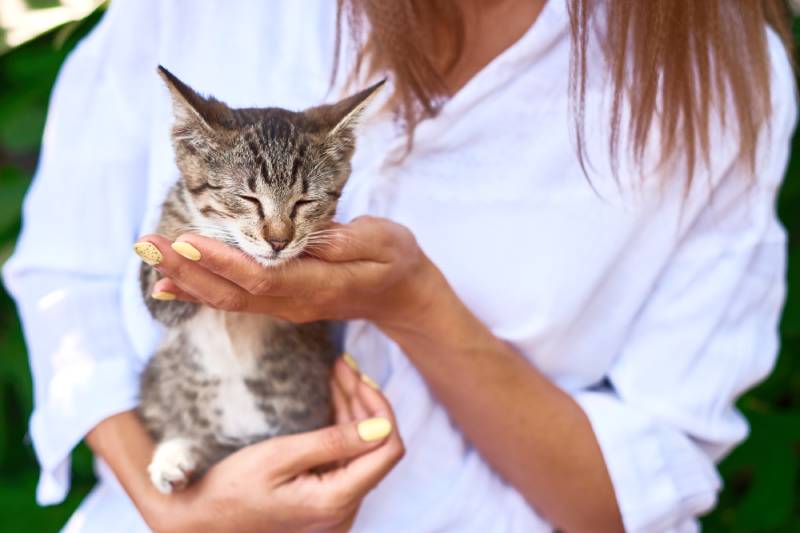How to Stop Your Cat From Over-Grooming: 11 Vet-Approved Methods
Updated on
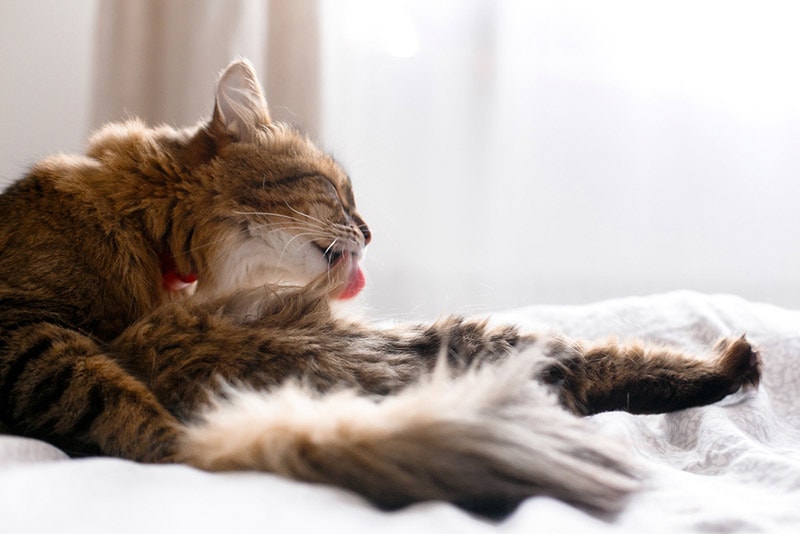
Cats are known for their ability to groom themselves. They usually keep themselves relatively clean, so they hardly need our intervention. However, sometimes, they keep themselves a little too clean. In these situations, they can lose hair and even develop sores. A cat’s tongue is quite rough and can seriously damage their coat and skin if a cat overgrooms. This can lead to secondary infections, which can be serious.
It is not always easy to stop your cat from over-grooming. They will likely do it when you are not around and may simply relocate if you try to physically prevent them from overgrooming. There are a few methods that you can take to prevent your cat from injuring themselves while grooming, though. We discuss these methods here.
The 11 Ways to Stop Your Cat From Over-Grooming
1. Figure Out Why Your Cat Is Overgrooming
There are several reasons that your cat may be overgrooming. They may be stressed. This can cause them to seek out relaxing behaviors, such as grooming. Too much grooming is not a good thing, though, even if it helps your feline calm down.
Food allergies often cause itchiness. This itchiness can lead to overgrooming and biting behaviors, which can affect your cat’s skin and coat. This may look like overgrooming, though your feline is itchy.
Some cats may groom themselves if they are bored. This is a bit rarer because cats may prefer getting into trouble if they are bored. However, excessive grooming can result from your cat simply not having anything else to do.
Knowing the reason that your cat is overgrooming is important for stopping it. Sometimes, your cat may need a new dietary change if they are allergic to something in their food. Toys and other stimulating objects may need to be added if your cat is bored. Stress is more difficult to deal with because you can’t always directly affect the reason that your feline is stressed.
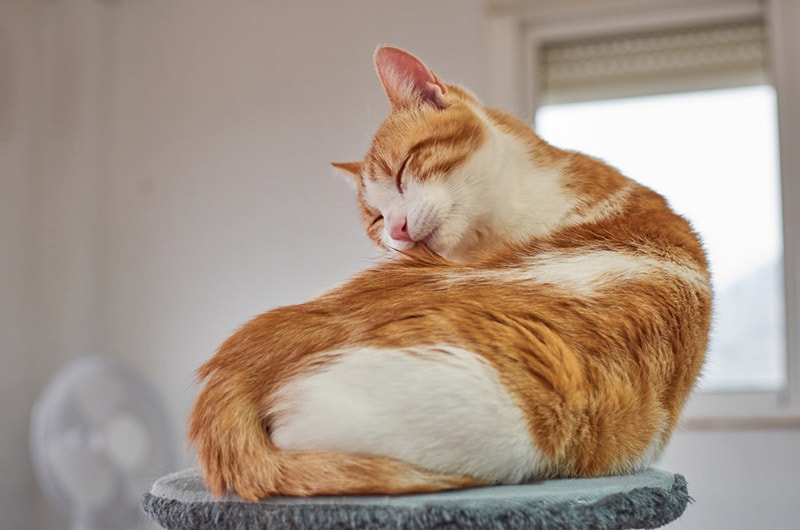
2. Make Your Home Less Stressful
In many circumstances, cats will groom themselves when they are stressed. Sometimes, though, they may groom a little too much. Lessening some of the stress in your household can prevent this excess grooming.
Cats can be easily stressed by seemingly normal things. For instance, cats may be vulnerable to seeing strange animals outside the window. As smaller animals, cats are often defensive around dogs and even other cats. They are also territorial, so just seeing a dog near the house outside can be stressful. If your cat often gets upset by animals walking by outside, close the windows so your cat can’t see them. Small changes like this may be all that your feline needs.
Some stressful situations can’t be fixed, though. For instance, moving to a new home is extremely stressful for cats, but it can’t always be avoided.
Loud noises may also stress out some felines. Be sure your cat has somewhere quiet that they can escape to if things become too loud for them. Something that they can climb and hide in, like a cat tree, is a perfect option for this. Be sure to place it in a quiet section of the house, preferably where their food and litter box is located.
Pet parents with anxious kitties know the pain of watching their companions be uncomfortable—that’s where the Hepper Nest Bed comes in. Our product is designed with nervous pets in mind. The bowl shape with high rounded sides comforts your cat to make them feel safe and secure, while the self-warming, sherpa fleece insert and flexible molded foam ensure that they stay as cozy as possible. Learn more about how the Next can calm your anxious pet here.
3. Increase the Number of Resources
If you have multiple cats in your home, they can become stressed by a “lack of resources.” While you may know that there is a full bag of food in the laundry room, cats don’t understand this. If there is only one food bowl split among three cats, they may begin to feel stressed at the potential lack of food. This can cause territorial guarding behavior, where one cat often guards the food bowl. In the end, this just stresses everyone out more.
For multi-cat households, you should have multiple spots where your cat can eat and get water. This prevents them from stressing about resources because they know of several spots that they can go to if one happens to be empty. It also minimizes the impact of any guarding that takes place, as the other cats can simply go to other food bowls.
The food bowls should be placed in different rooms. Putting two food bowls next to each other isn’t that helpful, as cats often will not eat that close together. If one cat decides to guard the food, they can limit the other’s access to both food bowls at the same time. They should be placed far apart so cats can eat at the same time without interacting with each other.
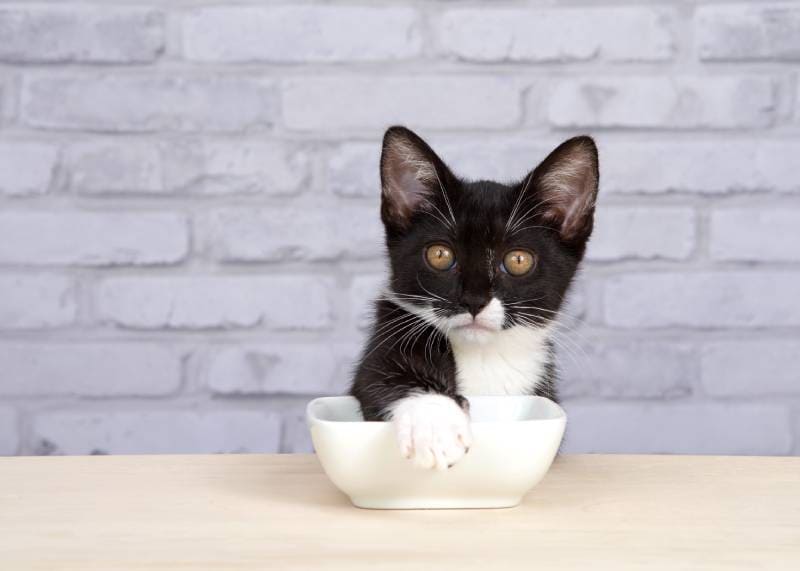
4. Put the Litter Box, Food, and Water in Appropriate Locations
Sometimes, the location of our cat’s resources can cause stress. For instance, if the food bowl is located in a high-traffic area, your cat may become needlessly stressed when visitors come over. If the litter box is next to the dryer or washer, your feline may get scared while trying to use it. Preferably, all your cat’s necessary items should be placed in quiet, easy-to-access places.
If you have more than one feeding station or litter box, you should do your best to place them on opposite ends of the house in quiet locations. This may not always be possible, depending on the size of your home. Putting food bowls away from each other is more important than keeping the food in a quiet area. However, you should be sure that there is at least one food bowl and litter box in a secluded place.
5. Introduce Other Cats Appropriately
If you are introducing a new feline into your home, be sure to do it appropriately to avoid either cat getting too stressed. Just throwing the new cat into your home will cause stress on both ends. Instead, you should confine the new cat to its area. This also gives the new cat a “safe zone” that they can use after they have been introduced to your other felines.
You can leave the new cat’s food and water in their safe place after introduction. The cats will probably continue to use their “own” food and litter box even after they are both roaming the house. This will prevent stress, as each cat will have their own space to escape to if necessary.
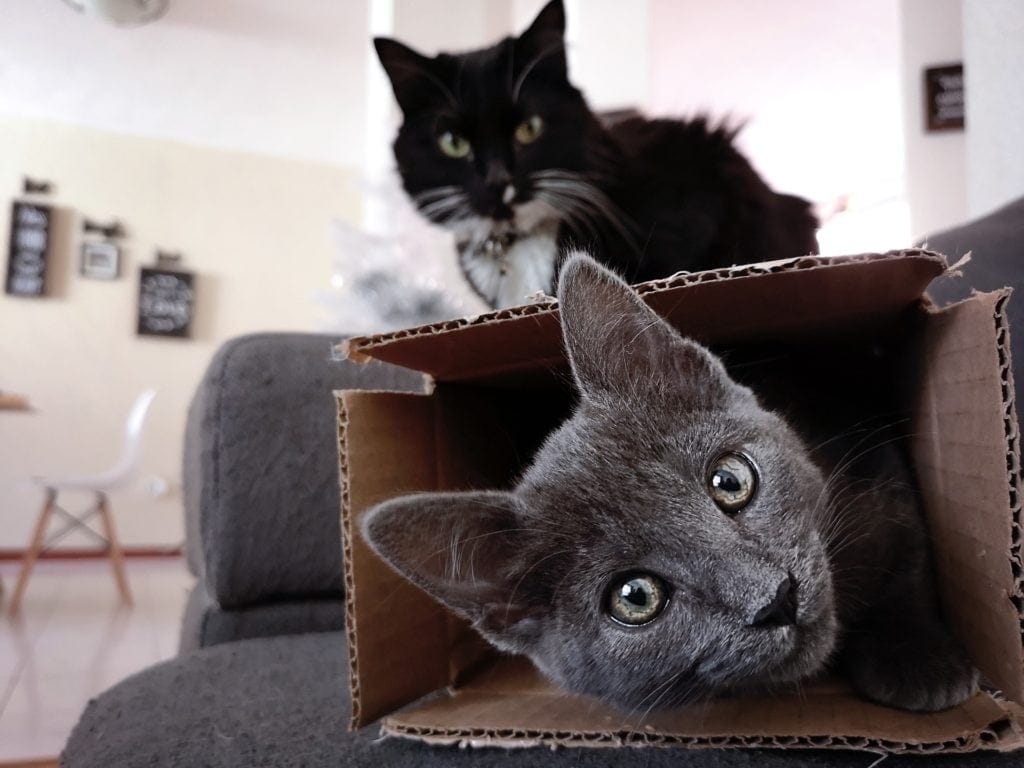
6. Introduce Hiding Places
Cats are good at finding places to hide. Under tables and on the top of cabinets are typically all open for a cat to hide. However, in some circumstances, they are unable to hide, which can cause stress. This is a common situation in hallways, where there usually isn’t much furniture. If you can provide your cat somewhere to hide in these tighter quarters, their stress levels may diminish.
If there’s a particular spot in your home where conflict seems to happen, introduce more hiding spots and verticality. If cats are stuck on the same level together, they may find it difficult to get along. When one can hide or get above the other one, stress levels can be greatly diminished.
7. Consider Medication
Many non-medication options are available for calming your cat down and preventing overgrooming. However, sometimes, medication is required. This is especially true for stressful situations that can’t be remedied, like a new baby in the house or an unavoidable change in routine. Luckily, many medication options are fairly non-invasive.
Pheromones
Synthetic pheromones can be a solution. Mother cats give off calming pheromones when they nurse their kittens. There are synthetic versions of this available on the market that often have a calming effect on adult cats. You can choose collars that have the pheromone embedded, as well as diffusers for trouble spots. These pheromones are undetectable by people, and there are few side effects. They can take a few weeks to work completely, though.
Zylkene
Another option is the dietary supplement Zylkene. It is made out of milk peptides that may calm cats down. It is a nutraceutical, which means it is not a drug but can produce drug-like effects. In other words, it’s a dietary supplement that can have significant effects on a feline.
Usually, this supplement takes about 7 days to work, though you may begin to see results almost instantly. This supplement must be given to a cat for 4-6 weeks to break habits like overgrooming. It works best for short-term, stressful situations, like airplane boarding and getting used to a new baby.
Prescription Medication
If your cat is having serious overgrooming problems, your vet may recommend medication. Overgrooming can lead to sores, which can become infected. These are called secondary infections because they’re secondary to the overgrooming behavior. These infections can be serious and life-threatening. Treating them is complicated, as the feline will often continue to overgroom that area and break the sore back open. If the wound doesn’t heal, getting rid of the infection completely is nearly impossible. Reemerging infections are common.
For this reason, the grooming behavior also needs to be treated. If your cat already has an infection, you may not have time to try other methods. Medication may also be necessary if other methods have failed.
Clomipramine is a licensed medication used to treat stress and anxiety in cats. It is prescribed together with behavioral modification techniques to treat obsessive-compulsive behaviors, like overgrooming. Your veterinarian is the right person to determine if this is a good treatment option for your cat, as this medication is contraindicated for some cats. Follow your veterinarian’s prescriptions and recommendations and keep in mind that this medication should not be stopped abruptly but rather weaned off gradually.
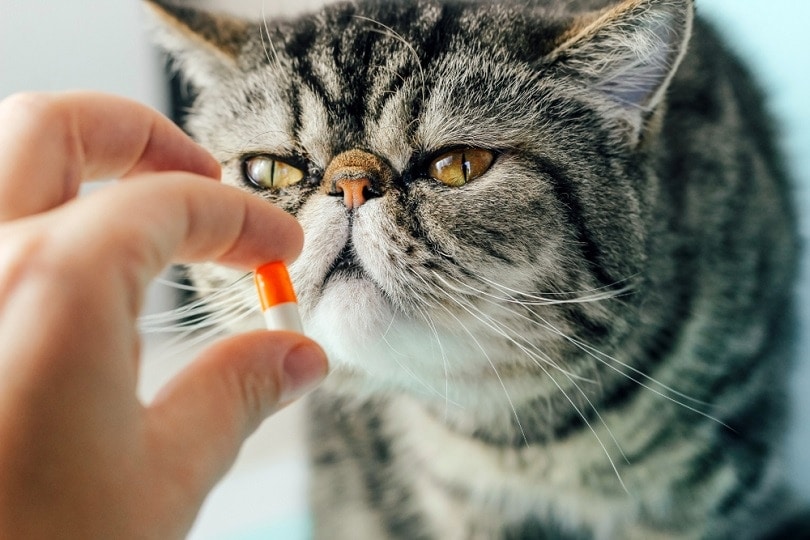
8. Change Their Food
Sometimes, overgrooming isn’t caused by stress. Instead, it can be linked to food allergies. Many allergies cause itchiness in cats. If your feline is allergic to something in their food, the easiest way to fix the problem is to change their food. Cats are often allergic to the protein source in their food. Switching to a food that includes a different protein source may help reduce overgrooming.
Speak to your veterinarian about this, they can guide you on how to try elimination methods based on limited-ingredient diets to figure out what your cat might be allergic to and find out what would be the best diet option for your kitty.
9. Check for Parasites
Parasites can also cause an allergic reaction. Some cats are allergic to fleas’ saliva, though ear mites can cause allergies as well. You can check for these parasites yourself, though you may need to visit the vet to rule them out completely.
Treating the parasites is essential to reduce overgrooming. Often, once the parasites have been removed, the cat will stop itching and grooming so much.
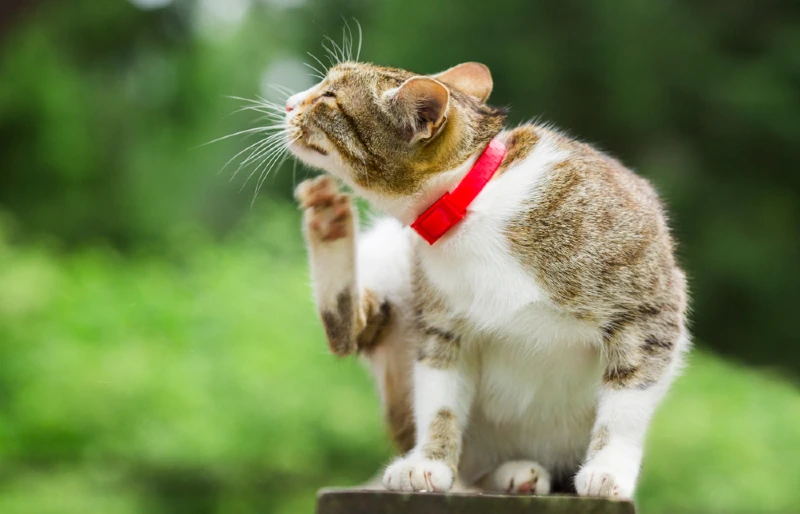
10. Check for Other Medical Problems
Pain can also cause overgrooming. Grooming releases serotonin, which makes cats feel good. This is why they use it for stress relief. However, they can also use it as natural pain relief. Cats are notoriously good at hiding their illnesses. Sometimes, they will overgroom themselves in an attempt to reduce their pain.
Your vet may need to check for underlying health problems that may be causing your feline pain. Usually, this will involve simple but effective tests, like blood analysis.
Once these underlying conditions are brought under control, your feline will likely stop overgrooming. Sometimes cats stay in the habit, though.
Illnesses can also be stressful, especially if a change in diet or routine is required. For this reason, other steps may need to be taken to treat the overgrooming on top of treating the original medical problem.
11. Add Stimulation
Some cats overgroom because they are bored. This isn’t as common as the countless other reasons that they could be overgrooming, though. You may want to check for health problems and try a few other steps first. However, adding stimulation to keep your cat from getting bored can be inexpensive and requires little time.
Puzzle toys are extremely helpful. You can buy pre-made options or make your own. Both are effective. Puzzle toys give cats a way to stretch their brain, which is essential for many breeds. Training can also provide mental stimulation.
On top of mental exercise, cats need physical exercise. While cats often have plenty of room to run around the house, we can’t always trust that they are getting the exercise that they need. Adding climbing structures and maintaining a regular rotation of toys can keep your feline interested and stimulated.
Conclusion
There are many methods you can try in an attempt to ease your cat’s over-grooming behaviors. If you’re still unsure of how to tackle the issue or you become more concerned, your best bet would be to contact your veterinarian.
Featured Image Credit: Bogdan Sonjachnyj, Shutterstock




